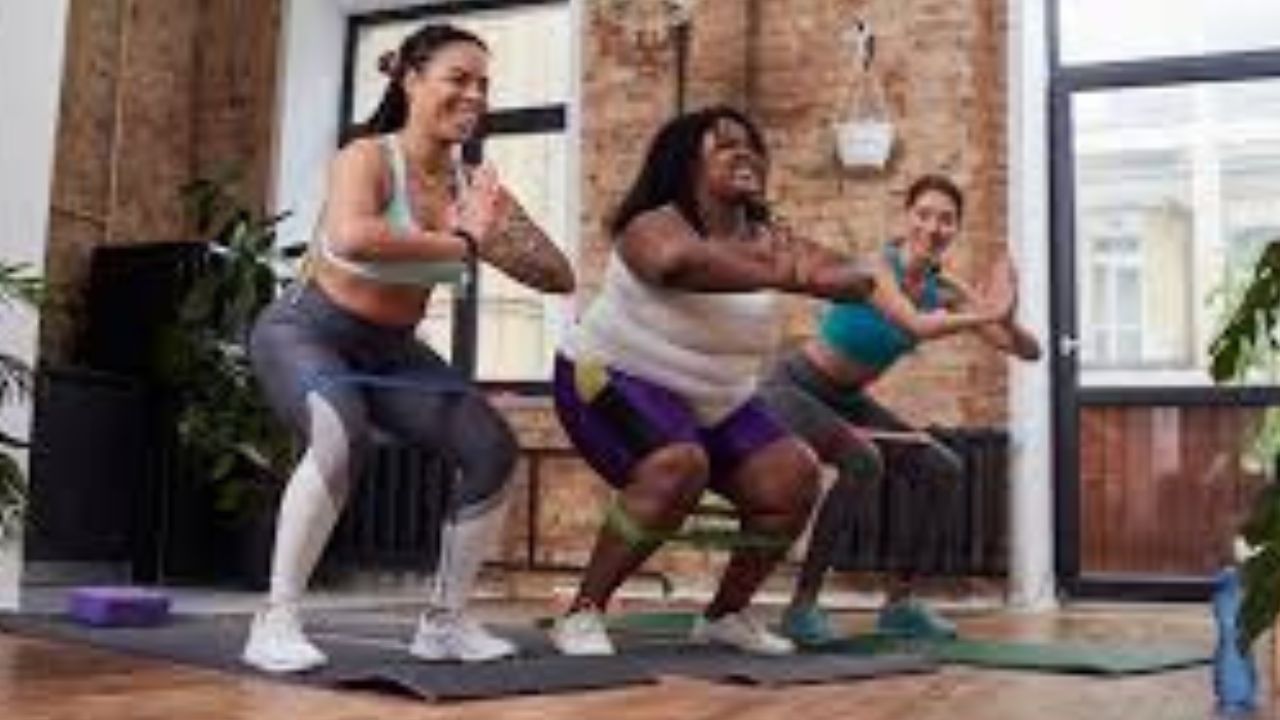American Heart Association Physical Activity Recommendations
This briefing summarises key recommendations and insights from the American Heart Association (AHA) and associated sources regarding physical activity for adults and children, emphasising the significant health benefits and strategies for overcoming common barriers.
I Core Recommendations for Physical Activity
The overarching message from the AHA is clear: “Move more, with more intensity, and sit less.” These recommendations are based on scientific evidence linking physical activity to overall health, disease prevention, and quality of life.
A. For Adults:
- Aerobic Activity: Adults should aim for “at least 150 minutes per week of moderate-intensity aerobic activity or 75 minutes per week of vigorous aerobic activity, or a combination of both, preferably spread throughout the week” (AHA Recommendations for Physical Activity in Adults and Kids).
- Muscle Strengthening: Incorporate “moderate-to-high-intensity muscle-strengthening activity (such as resistance or weights) on at least 2 days per week.” (AHA Recommendations for Physical Activity in Adults and Kids).
- Minimising Sedentary Time: It is crucial to “spend less time sitting. Even light-intensity activity can offset some of the risks of being sedentary.” (AHA Recommendations for Physical Activity in Adults and Kids).
- Increased Benefits: “Gain even more benefits by being active at least 300 minutes (5 hours) per week.” (AHA Recommendations for Physical Activity in Adults and Kids).
- Gradual Progression: Individuals should “increase amount and intensity gradually over time” (AHA Recommendations for Physical Activity in Adults and Kids).
B. For Kids:
- Children 3-5 years old: Should be “physically active and have plenty of opportunities to move throughout the day.” A good goal is “about 3 hours per day of a variety of activities (light, moderate and vigorous).” (AHA Recommendations for Physical Activity in Adults and Kids; AHA Recommendations for Physical Activity in Kids Infographic).
- Kids 6-17 years old: Need “at least 60 minutes per day of moderate- to vigorous-intensity physical activity, mostly aerobic.” This can be broken into shorter sessions. (AHA Recommendations for Physical Activity in Adults and Kids; AHA Recommendations for Physical Activity in Kids Infographic).
- Vigorous Activity: Include “vigorous-intensity activity on at least 3 days per week.” (AHA Recommendations for Physical Activity in Adults and Kids).
- Muscle and Bone Strengthening: Include “muscle- and bone-strengthening (weight-bearing) activities on at least 3 days per week.” (AHA Recommendations for Physical Activity in Adults and Kids).
- Gradual Progression: “Increase amount and intensity gradually over time.” (AHA Recommendations for Physical Activity in Adults and Kids).
- Sedentary Time for Kids: Children should not be sedentary for longer than 60 minutes at any given time.” (Physical Activity, How Much Is Enough? | Active Kids Are Healthy Kids).
II. Understanding Intensity
Physical activity encompasses any movement that burns calories, from walking to stretching.
- Aerobic (Cardio) Activity: Elevates heart rate, improving cardiorespiratory fitness.
- Moderate-intensity: “Your heart will beat faster and you’ll breathe harder than normal, but you’ll still be able to talk.” Examples include brisk walking, water aerobics, dancing, gardening, doubles tennis, and biking slower than 10 mph. (AHA Recommendations for Physical Activity in Adults and Kids).
- Vigorous-intensity: Requires a higher effort, making you “get warm and begin to sweat” and unable to “talk much without getting out of breath.” Examples include uphill hiking, running, swimming laps, aerobic dancing, heavy yardwork, singles tennis, cycling 10 mph or faster, and jumping rope. (AHA Recommendations for Physical Activity in Adults and Kids).
- Structured vs. Unstructured Play (for Kids): The University of Nevada, Reno, Extension recommends a “60-60-60” rule: “60 mins of STRUCTURED activity daily, 60 mins and up to several hours of free play or UNSTRUCTURED activity daily! 60 mins of sitting is long enough! GET UP after 60 minutes and move!” (Physical Activity, How Much Is Enough? | Active Kids Are Healthy Kids).
- Structured play is “adult-led” with intended goals, teaching fundamental movement skills (e.g., hopscotch, Red Light Green Light, sports drills).
- Unstructured play is “active free-play” where children choose their activities (e.g., school playground, park, nature walks).
III. Significant Health Benefits of Physical Activity
Regular physical activity offers a wide range of benefits for all ages, significantly impacting long-term health and well-being.
- Reduced Risk of Chronic Diseases: Lower risk of “heart disease, stroke, type 2 diabetes, high blood pressure, dementia and Alzheimer’s, several types of cancer, and some complications of pregnancy.” (AHA Recommendations for Physical Activity in Adults and Kids).
- Improved Mental Health: Benefits include “fewer symptoms of depression and anxiety,” improved mood, and “reduced feelings of stress.” (AHA Recommendations for Physical Activity in Adults and Kids; What’s the Link Between Physical Activity and Health?). For children, it improves the “ability to handle physical and emotional challenges.” (Physical Activity, How Much Is Enough? | Active Kids Are Healthy Kids).
- Enhanced Cognitive Function: Better sleep, “improved cognition, including memory, attention and processing speed,” and for children, “improved brain development, function and creativity,” and even “improve health conditions such as Attention Deficit Hyperactivity Disorder.” (AHA Recommendations for Physical Activity in Adults and Kids; What’s the Link Between Physical Activity and Health?; Physical Activity, How Much Is Enough? | Active Kids Are Healthy Kids).
- Physical Health Improvements: Less weight gain, reduced obesity, better bone health and balance (less risk of falls), and “improved cardiorespiratory fitness.” (AHA Recommendations for Physical Activity in Adults and Kids; What’s the Link Between Physical Activity and Health?).
- Overall Quality of Life: Leads to “better quality of life and sense of overall well-being” (AHA Recommendations for Physical Activity in Adults and Kids).
IV. The Dangers of Sedentary Behaviour
- Significant Health Risks: “Science has linked being inactive and sitting too much with higher risk of heart disease, type 2 diabetes, colon and lung cancers, and early death.” (AHA Recommendations for Physical Activity in Adults and Kids).
- Beyond Exercise: Even for those who exercise regularly, “prolonged sedentary time can be bad for your heart and blood vessels regardless of how much physical activity you get.” (Sitting too much may raise heart disease risk). As Marc Hamilton, Ph.D., states, “30 minutes a day of exercise can’t immunise you from what you do the other 23-and-a-half hours.” (Sitting too much may raise heart disease risk).
- Rising Sedentary Time: U.S. adults spend an estimated six to eight hours a day in sedentary activities, with some research suggesting over nine hours. (Sitting too much may raise heart disease risk).
- Children’s Screen Time: Experts recommend “kids over 2 should get no more than one to two hours of screen time a day except to do homework,” yet average usage is significantly higher (4-6 hours for 8-12 year olds, 9+ hours for teens, excluding homework). (Limit Screen Time and Get Your Kids (and the Whole Family) Moving).
V. Overcoming Barriers to Physical Activity
The most common barrier is “lack of time.” (Breaking Down Barriers to Fitness). However, various strategies can help:
A. Common Barriers and Solutions:
- Lack of Time: Identify 30-minute slots in your week.
- Choose activities that fit into your home or work routine (e.g., walking in your neighbourhood, climbing stairs at the office, exercising while watching TV).
- “Make it a habit to walk and talk” during work calls.
- Schedule walking meetings. (Breaking Down Barriers to Fitness).
- Friends and Family Don’t Share Interest:Share goals and ask for support.
- Get active together as a family, including pets.
- Invite friends to participate.
- Join a local YMCA or walking club; group activities increase exercise time and benefits.
- Alternate workout times with a friend for childcare. (Breaking Down Barriers to Fitness).
- Lack of Motivation/Energy: Plan (e.g., keep sneakers in the car/at work).
- Schedule activity at specific times and check it off.
- Identify your most energetic time of day.
- Join a group for motivation and accountability.
- Remember, “taking that first step… is often the hardest part, but once you’re moving, your lack of motivation should fade.” (Breaking Down Barriers to Fitness).
- Lack of Resources/Equipment (Expense or Travel): Select activities requiring minimal equipment (e.g., walking, jogging, jumping rope, callisthenics).
- Utilise inexpensive community resources (parks, recreation programs, worksite wellness groups).
- Explore free virtual exercise activities (e.g., AHA’s online workouts).
- Pack walking shoes for travel and use the hotel fitness facilities. (Breaking Down Barriers to Fitness).
- Feeling Uncertain or Uncomfortable:Consult a healthcare professional for appropriate exercises.
- Start slow, especially with walking.
- Recruit a walking partner, wear comfortable shoes, and choose safe locations.
- Use walking poles for balance if needed.
- Consider beginner group exercise classes.
- “Any exercise is better than none.” (Breaking Down Barriers to Fitness).
B. Tips for Long-term Success:
- Preparation: “Dress for success!” with comfortable, properly fitting attire. (Getting Started: Tips for Long-term Exercise Success).
- Consistency: Start slowly and gradually build up. Exercise at the same time daily to form a habit, but be flexible if you miss a session. (Getting Started: Tips for Long-term Exercise Success).
- Realistic Expectations: Consult a healthcare professional if you have chronic conditions. Look for opportunities to be active throughout the day (e.g., walking the mall, taking stairs). Don’t get discouraged by breaks; just restart gradually. (Getting Started: Tips for Long-term Exercise Success).
- Enjoyment: Choose activities that are fun and offer variety to avoid boredom. Involve family and friends. Use music or audio books while being aware of surroundings. (Getting Started: Tips for Long-term Exercise Success).
- Track Progress: “Note your activities on a calendar or in a logbook.” Reward yourself at milestones with non-food items. (Getting Started: Tips for Long-term Exercise Success).
VI. Encouraging Family Physical Activity
- Parental Role Models: “Practice what you preach.” Children are more likely to be active if they see adults being active. (Limit Screen Time and Get Your Kids (and the Whole Family) Moving; Physical Activity, How Much Is Enough? | Active Kids Are Healthy Kids).
- Family Planning: Make a plan for screen time limits and offer age-appropriate active alternatives. Schedule physical activity as a regular family event. (Limit Screen Time and Get Your Kids (and the Whole Family) Moving).
- Active Togetherness: “Experts say that what kids want more than anything is time with their parents.” Don’t just send them to play, “go play with them!” (Limit Screen Time and Get Your Kids (and the Whole Family) Moving).
- Screen-Free Zones/Times: Designate areas (dining room, bedrooms) and times (homework, before bed) where devices are prohibited. Avoid using TV as a reward or punishment. Plan TV watching rather than passive viewing. (Limit Screen Time and Get Your Kids (and the Whole Family) Moving).
- Alternative Activities: Encourage family game night, shooting hoops, walking the dog, exploring parks, dancing, or doing active chores. (Limit Screen Time and Get Your Kids (and the Whole Family) Moving).
- Communication with Caregivers: For children in childcare, open communication between parents and providers is vital to ensure physical activity goals are met, as studies show children in childcare are “generally NOT active!” (Physical Activity, How Much Is Enough? | Active Kids Are Healthy Kids).
In conclusion, the American Heart Association and supporting organisations provide comprehensive guidelines for physical activity across all age groups, strongly advocating for increased movement, higher intensity, and reduced sedentary behaviour to significantly improve overall health, reduce disease risk, and enhance quality of life. The emphasis is on starting small, making activity enjoyable, involving family, and strategically overcoming common barriers.

